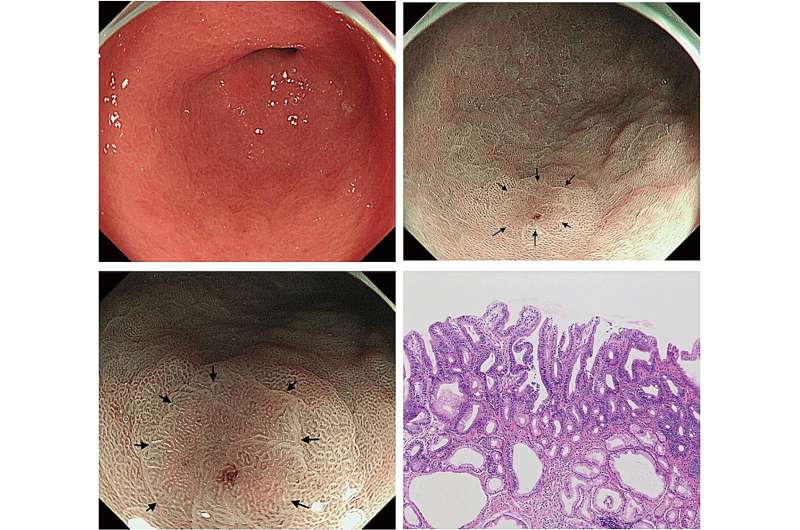This article has been reviewed according to Science X's editorial process and policies. Editors have highlighted the following attributes while ensuring the content's credibility:
fact-checked
proofread
Narrow-band imaging at low magnification can detect lesions overlooked by white-light imaging

Helicobacter pylori infection is recognized as a significant risk factor for gastric cancer. Hence regular screening for early detection is particularly crucial in regions with a high prevalence. While advancements in endoscopy facilitate the removal of substantial neoplasms, preference is given to identifying smaller lesions. However, at the same time, the detection of faint epithelial neoplasms remains challenging.
To that end, in a recent study published in the journal Gastroenterology & Endoscopy, a Japanese researcher introduced an alternative approach.
"The efficacy of using LM-NBI for comprehensive stomach observation following routine WLI has been demonstrated," says Ryuichi Nagashima, sole author of the study. "LM-NBI can detect minute lesions overlooked during white-light imaging (WLI), especially those situated in regions of map-like redness or atrophic/metaplastic mucosa within the stomach."
Such lesions account for approximately a quarter of all newly diagnosed small neoplasms. Nonetheless, there exists a gap in studies that validate the efficacy of periodic LM-NBI examinations in comparison with conventional magnifying endoscopy (CE).
"Therefore, my objective was to evaluate the efficacy of annual endoscopic examinations using LM-NBI for the entire stomach following WLI, aiming to detect gastric neoplasms," says Nagashima.
In the LM-BMI and CE groups, the initial endoscopy, which standardized the baseline, was followed by annual endoscopies up to five times. The first annual examination took place between April 2019 and March 2020 in the LM-NBI group and between April 2015 and March 2016 in the CE group. A retrospective analysis of medical records was conducted to assess the detection of gastric tumors.
Nagashima found that of the 388 patients in the LM-NBI group and 381 in the CE group, 15 and five patients with gastric neoplasia were respectively identified, excluding one mucosa-associated lymphoid tissue lymphoma. All cases were identified to be epithelial neoplasia.
"Endoscopic examinations were performed safely without complications requiring additional interventions. The Cox proportional hazards model determined a hazard ratio of 2.78 (95% CI, 1.01–7.64). Kaplan–Meier analysis (p = 0.039, log-rank test) revealed superior efficacy of annual LM-NBI over CE in detecting gastric neoplasia," explains Nagashima.
This historical case-control study highlights the threefold higher detection rate of neoplastic lesions in the stomach through annual LM-NBI following WLI compared to CE. Notably, it is the first study to affirm the efficacy of annual endoscopy using LM-NBI for detecting gastric neoplasms, particularly in regions of map-like redness or atrophic/metaplastic mucosa.
"While LM-NBI successfully identified lesions overlooked by WLI, its efficacy in detecting diffuse-type carcinomas remains uncertain, especially for signet ring cell carcinomas," notes Nagashima.
Recognizing the tendency of observers to focus on color changes in WLI, the study underscores the importance of tandem examinations using both WLI and NBI for comprehensive lesion detection.
"Further studies are needed to clarify the superiority of LM-NBI over other image-enhanced endoscopies, such as blue laser imaging bright and linked color imaging, to establish its optimal role in clinical practice," concludes Nagashima.
More information: Ryuichi Nagashima, Validity of low-magnification narrow-band imaging in annual endoscopy screening for gastric neoplasms: A case-control study, Gastroenterology & Endoscopy (2023). DOI: 10.1016/j.gande.2023.10.002
















